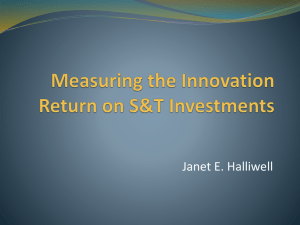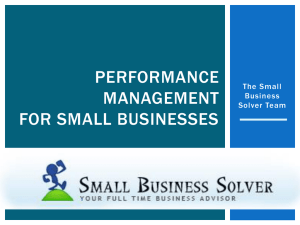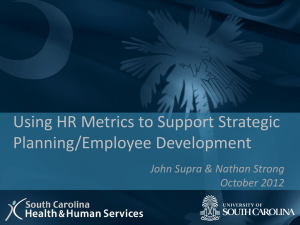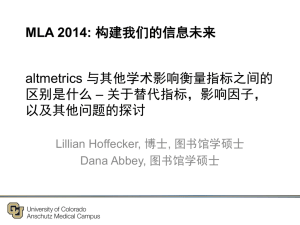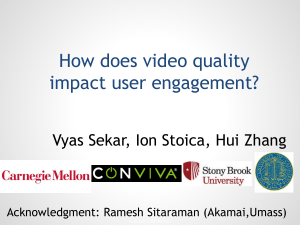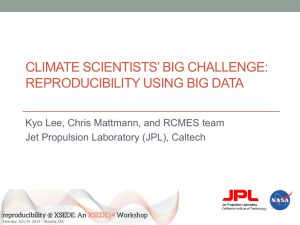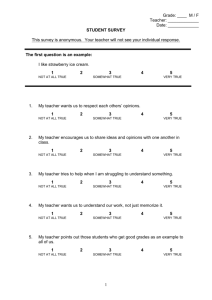PowerPoint
advertisement
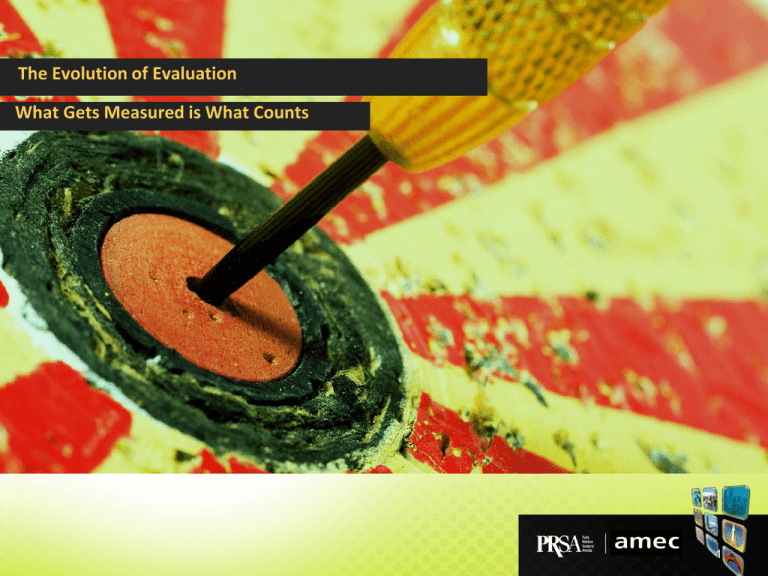
The Evolution of Evaluation What Gets Measured is What Counts 1 Chris Foster Vice President Strategy & Organization Booz I Allen I Hamilton 2 Communicating with the C-suite Communications Measurement is Seen as an Add-On “You have to move beyond the obvious metrics such as media impressions, Facebook "likes" and Twitter followers. Those can provide a clue to your reach. If you really want to show your effectiveness, you need to decide what needle you want to move—sales, fundraising activity or advocacy reach, for example—and then measure your media activity against that.” - Laura Howe, VP, public relations at the American Red Cross • The C-suite executives expect metrics and prefers those of outcome-oriented persuasion • Although PR practitioners note that engagement is a best practice, most still rely on impressions as evidence of impact • Measures must move beyond mere impressions (outputs) to understanding comprehension of message (outtakes), and ultimately, to understanding how the message impacted the target audience’s attitudes and emotions (outcomes). 3 Similarities Across Markets (Global Survey Results) • We need metrics that support business decisions • Web metrics such as sentiments and perceptions are most effective measures of digital media impact • Economy has had a negative effect on communications and measurement budgets • We need much deeper understanding of communications measurement best practices • Greatest need is for a common ROI definition • We need standard metrics for ROI and communications effectiveness October 2012 Research Results 5 Tracking challenges Difficult to show bottom line impact Intangible value Hard to link cause and effect Cost Red tape Poor skill sets What are the biggest challenges to measuring the value of public relations? Changing market dynamics PR measurement and media relations measurement are not synonymous Communication barriers Lack of standards Not black and white Measuring intangible value Lack of support Tough to correlate Defining/measuring ROI with impact Lack of time Changing visions Measuring outcomes over outputs 6 Poor methodology Leadership buy-in Lack of consensus Not persuasive enough Seen as hassle Lack of resources No one size fits all Lack knowledge What do you believe are the greatest barriers to the adoption of standardized research techniques for the measurement of public relations? Lack of standard benchmarks Lack of standards Institution-wide inertia Communication barriers Varied business models 7 Importance of PR Measures On a scale of 0 to 10, where “0” is unimportant and “10” is important, how important is it the following are well understood across the public relations profession in the next five years? Incidence of “Very” and “Somewhat Important” Rating Setting measureable objectives 91% How to attribute the impact from a PR program on business goals / objectives 88% What should be measured beyond media clips 84% The benefits of measuring a PR campaign 84% Ensuring standard approaches to measurement throughout an organization 82% Measuring the value of building relationships with influencers 79% How to measure the ROI of my PR campaign / spend 77% How to measure social media 77% How to measure the impact of an event 75% 60% 70% 80% 90% 100% Base: All respondents n=57 8 Importance of PR Measures On a scale of 0 to 10, where “0” is unimportant and “10” is important, how important is it the following are well understood across the public relations profession in the next five years? Incidence of “Very” and “Somewhat Important” Rating Measuring the effects of sponsorships 75% How PR activities can be incorporated into a company's Marketing Mix Modeling 74% How often to measure an on-going campaign or program 72% How soon after a campaign to measure 70% Isolating the effect of PR from other campaign activities 70% How to measure the value of corporate reputation programs 70% How to measure the value of employee engagement 60% Percent of PR campaign that should be spent on measurement Base: All respondents n=57 53% 0% 25% 50% 75% 100% 9 Attribute Assessment How much do you agree or disagree with the following statements, where “5” is “strongly agree” and “1” is “strongly disagree”? Incidence of “Strongly” and “Somewhat Agree” Rating Common definitions for the ROI of public relations are needed 74% The language of PR measurement needs to change to connect better with the C-suite and Board table 72% Global PR organizations should make educating organizations about the proper measurement of PR a top priority 67% The Barcelona Principles were a good start, but now we must get much more specific 55% Common terms and definitions for the measurement of PR do not exist at all 23% A common set of standards are not applied in the PR measurement profession 19% A common set of standards for PR measurement is unnecessary 16% The Barcelona Principles are the common set of standards the industry had been lacking 11% 0% 25% 50% 75% 100% Base: All respondents n=57 10 Challenges / Barriers to Measurement What are the challenges/barriers to measurement that you encounter? Below are statements about barriers to measuring communications that you may or may not agree with or hear most commonly from clients. Using the scale where “0” means you completely disagree with that statement and a “10” means you completely agree with that statement, please rate each of the following. Incidence of “Very” and “Somewhat Agree” Rating I don't have the internal staff to conduct research on communication effectiveness 68% There isn't an effective tool to measure the impact of communications 46% Senior management doesn't value communications measurement and research 42% It's more important to spend budget on communications programs than measurement and research 39% It's not possible to measure the impact of social media on my audiences 12% It's not possible to measure the return on investment for public relations activities 12% Communications measurement does not improve my job performance Base: All respondents n=57 9% 0% 25% 50% 75% 100% 11 Digital Media Impact Metrics Below is a list of metrics that may be used to measure the impact of digital media. Based on your experience or by what you read and hear, which one do you consider most effective? Survey research to measure audience awareness, sentiments and perceptions 44% Website metrics (volume, unique hits, time spent on site, page views) 21% Volume of online mentions (Twitter, Facebook, etc.) 9% Key word search metrics 4% Measure of online sentiment through social media monitoring tool 2% Other 16% There are no metrics or methods to effectively measure the effect of digital media 5% 0% 25% 50% 75% 100% Base: All respondents n=57 12 Importance of Competencies Public Relations Professionals On a scale of 0 to 10, where “0” is unimportant and “10” is important, how important are each of the following competencies for a public relations professional? Incidence of “Very” and “Somewhat Important” Rating Has knowledge of different outcome measures 92% Understands the benefits of different media measurement techniques 92% Able to advise clients how measurement drives business performance 89% Measuring quality and does not rely on simple quantitative measure such as clips and impressions 89% 0% 25% 50% 75% 100% Base: Public Relations Professionals n=47 13 Importance of Competencies Public Relations Professionals On a scale of 0 to 10, where “0” is unimportant and “10” is important, how important are each of the following competencies for a public relations professional? Incidence of “Very” and “Somewhat Important” Rating Has clear understanding of research and metric terminology 87% Understands how analytics is part of integrated communications efforts across channels 87% Recognizes how to measure traditional and social media consistently 87% Understands how to write goals and objectives 87% Selects appropriate metrics for outputs, outcomes and business results 85% Knowledge of quantitative and qualitative research techniques 85% Emphasizes transparency in all facets of research 81% Create effective research proposal requests, vendor and tool selection, develop research budgets 70% 0% 25% 50% 75% 100% Base: Public Relations Professionals n=47 14 Effect of Economy on Communications Budget During the past three years, what impact, if any, has the economy had on your organization’s overall communications budget? Very nega ve effect 0.25 Somewhat nega ve effect 0.35 Very posi ve effect 0.02 Somewhat posi ve effect 0.05 Net: Positive effect 7% Negative effect 60% Base: All respondents n=57 Neither nega ve nor posi ve effect 0.33 15 Key Findings • Practitioners see many challenges to measuring the value of PR and implementing measurement into standard practice. Limitations on staff, time, budgets and a general lack of understanding of measurement principles contribute to this challenge. • In the past three years, the economy has had a negative effect on communications and measurement budgets, limiting resources while simultaneously increasing the importance to show the value in our work for clients. • Within five years, over 90% of surveyed public relations professionals indicated a need for the development of communication measurement standards and practices. • A desire for more effective measurement creates a need for measuring ROI and capturing true business impact. 16 Solution As an industry, we need to: •Change the way we communicate and present our value •Incorporate measurement in our missions and objectives •Use research-driven data to demonstrate the value that strategic communications delivers in a way that can be universally understood and embraced by budgets across the globe 17 Call to Action As an industry, we have a shared responsibility to: •Reframe how we talk about measurement and communications and the value of communications and PR •Seize opportunities to gain more understanding in measurement and identify how to implement into practice •Utilize communication as a tool in problem solving •Meet the demand for data-driven campaigns 18




